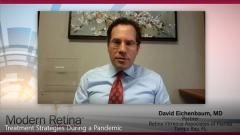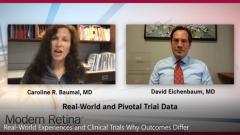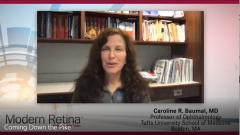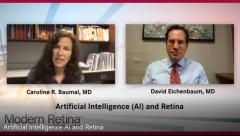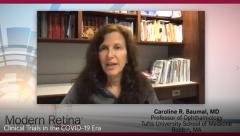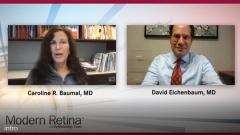
Telemedicine
Episodes in this series

Caroline R. Baumal, MD: Dr. Eichenbaum, let's move on to another topic and that's telemedicine. Especially with the recent pandemic related to COVID-19, have you been using telemedicine in your practice, and tell us what you think about it.
David Eichenbaum, MD: It’s a great question and very timely and topical. I have not used telemedicine in my practice for a couple of reasons. You and I practice subspecialty retina, and we're so dependent on our imaging that almost all of my medical retina decisions have an imaging component. The patients are either coming in for an image and a determination to treat and then set an interval for treatment based on that image, or they're coming in for treatment with an anti-VEGF on a fixed interval, or they're coming in for some kind of surgical triage which requires a macular exam and/or an exam for retinal tears and detachment and all that.
I think things like an anterior segment practice that deals with a lot of blepharitis and allergy could do some telemedicine, but even in the world of the red eye there are pitfalls to that. Is it corneal abrasion, is it superficial punctate staining, is it allergy, is it conjunctivitis? There are all these diseases. Is it high IOP? There's probably a greater role in the comprehensive practice, but until we have reliable and validated home diagnostics, I don't think that retina is quite ready for telemedicine in prime time, but the good news is those validated home diagnostics are coming.
Then we are going to see a massive role for telemedicine between longer duration treatments and the home diagnostics that we can use to determine the efficacy of those longer duration treatments. How about you? How much telemedicine have you done during the pandemic?
Dr. Baumal: We have a very visual subspecialty, and that's why I always tell the residents, the fellows, the more you see the more you're going to learn. I mean, so much of our job is being able to see things. If you had said to me a year ago, Caroline, you're going to be doing telemedicine in a year, I would have been like, ‘No, I'm not ready for that.’ But the pandemic has sort of forced our hand, and I would say that throughout this time I have used a little bit of telemedicine with very few of my patients.
I’ve more or less been calling them, and even though many of my patients have Amsler grids and I send some of them reading charts, going through them with them on the phone. But even though we don't have the ability to do imaging with our patients remotely, also another thing for telemedicine is being able to use the apps and having a smartphone to do telemedicine. I think many of my patients are over 85, and probably that is not something that they're very used to, using the apps, and so that's another thing that in particular limits us with our patient population in doing telemedicine.
I certainly have tried, and probably under 5% of patients I was able to do some sort of telehealth visit, usually a telephone call, very rarely telemedicine. They just did not have the smartphone ability to do that with me. And again, I think that we are limited in our ability to do this. For macular degeneration I have used Notal Vision home monitoring, which I know you’ve also used. Even that, patients do sometimes have difficulty with it, using the machine and having good fixation. I'm excited for Home OCT. I do think it's coming, and maybe this will make it come faster, the pandemic.
Dr. Eichenbaum: It’s going to be a huge part. The ease-of-use is going to be the key to that. There are these apps that I've beta-tested, and I know you've beta-tested, where patients take their own external photo, or they use a little digital Amsler grid. None of them are validated, and none of them seemed to help me in my practice of retina. The ForeseeHome device is something I had a good deal of experience with, and I think that's the portal. That was the “starter drug” to telemedicine. It's like the Atari 2600 of telemedicine. It certainly got our foot in the door. It does have some ease-of-use difficulties and visual acuity requirements and cognitive requirements that Home OCT hopefully would not. Then it has testing reliability and outcome issues that I think the Home OCT would not, but it's a very important device because it's the start of what I think is going to be huge.
I believe in the future of telemedicine once we have the reliable diagnostics to make it happen. I don't see where it would have changed my treatment paradigm in 2020 or 2021.
Dr. Baumal: I love the idea of Home OCT. I think it will help us treat our patients better with a more effective kind of treat-and-extend protocol. Maybe we won't be doing this extending 1 to 2 weeks, which isn't really based on science, but we can use some sort of Home OCT to help us better direct our patients. But I still feel like patients will need to have some sort of examination of the entire retina at least every certain interval so we don't miss some sort of peripheral pathology or uveitis or glaucoma, the things that we can't necessarily catch from an image
Caroline R. Baumal, MD: Hello and welcome to this discussion presented by Modern Retina and Ophthalmology Times titled, “Treating Age-Related Macular Degeneration in 2020. I'm Dr. Caroline Baumal. I'm a Professor of Ophthalmology at Tufts University School of Medicine in Boston. Please welcome—okay.
Please join me in welcoming my colleague, and not only my colleague but an ex-fellow from Tufts and a good friend of mine, Dr. David Eichenbaum, who is currently a partner at Retina Vitreous Associates of Florida in Tampa Bay. In today's discussion we'll talk about available therapies and some that are still in development as well as practical considerations in treatment of wet AMD during the post-pandemic era.
Newsletter
Keep your retina practice on the forefront—subscribe for expert analysis and emerging trends in retinal disease management.

